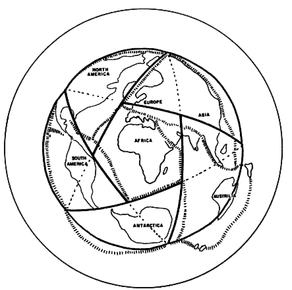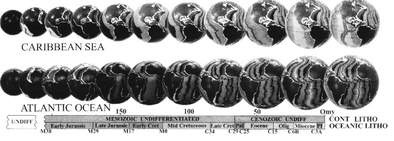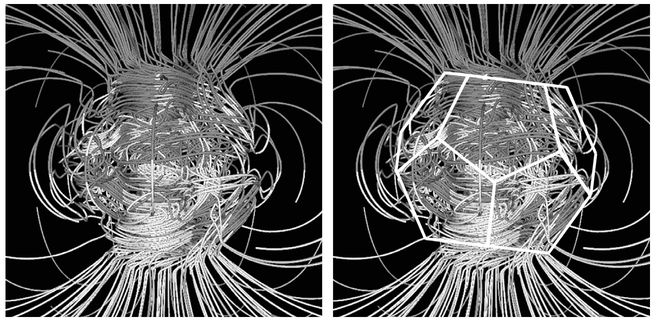The Source Field Investigations (48 page)
Read The Source Field Investigations Online
Authors: David Wilcock

The story begins with Dr. Hanshou Liu, of NASA’s Goddard Space Flight Center, who was the first to discover that when the original supercontinent Pangaea broke up 220 million years ago, it did so along equidistant lines—forming the edges of a pyramid-shaped geometry called a tetrahedron. In this case, you have a pyramid shape with an equilateral triangle on the bottom, and three more equilateral triangles making the sides.
In a discussion with Spilhaus, who was highly talented at creating unique map projections, they realized that the continents, volcanic ridges and seismic fault lines then moved into a shape that was a combination of a cube and an octahedron. An octahedron looks like two Egyptian pyramids base to base, where each face is again an equilateral triangle. From this phase, the earth again shifted—into the exact same pattern that was rediscovered by Sanderson in 1971 and the Russians in 1973. Spilhaus then created a special map projection where he took a single point in the Pacific Ocean and stretched it out into a great circle, so that everything on earth was inside this circle. From that perspective, the geometry became very, very obvious—covering the vast majority of all seismic and volcanic ridges with astonishing precision.

Earth’s continents, mountain ranges and undersea volcanic ridges later expanded into this icosa-dodeca geometry. A single point in the Pacific Ocean was widened to form the edge of the entire circle in this map projection by Spilhaus.
I personally contacted Dr. Hanshou Liu in June 2004 to see if this remarkable scientific story was true—and he gave me permission to publish the following statement.
Dear Mr. Wilcock: Dr. Athelstan Spilhaus visited me at NASA Goddard Space Flight Center in 1976, and asked for reprints of my three papers: Deformation and Instability of Underthrusting Lithospheric Plates, Dynamical Model for the Detachment of Descending Lithosphere, and On the Breakup of Tectonic Plates by Polar Wandering. . . . In 1976, I pointed out such a [geometric] pattern to Dr. Spilhaus in my office from my work. He was heartened to see that the breakup [of the earth] occurred along equidistant points and lines which formed a geometric solid known as a tetrahedron. . . . We had [also] discussed the possible cuboctahedron and icosadodecahedron stages of the lithospheric expansion. Before Dr. Spilhaus left my office, he commented [on] my work: “Now, your ideas about the breakup of the tectonic plates can be stated without mathematics, in a form that people without a scientific education can understand. Your combination of boldness, insight and courage has enabled you to produce ideas that have transformed our understanding of the dynamics of the earth.” As a mathematical physicist by training, I felt that I was honored.
18
18
Obviously, geometry now appears to have a much more significant role in the growth and development of the earth than we thought. The conventionally accepted model of plate tectonics, or what used to be called continental drift, can be traced all the way back to Dr. Alfred Wegener in 1912—and has remained largely unchanged for almost a century.
19
However, both Karl W. Luckert, professor emeritus of the University of Southern Minnesota,
20
and James Maxlow
21
-
22
have demonstrated clear scientific cases that the earth has been expanding from within since at least 220 million years ago—when the mega-continent Pangaea first separated. Maxlow simply subtracted each stage of expansion that the seafloor went through, worldwide, from the overall volume of the earth’s surface. The results are quite striking, as it appears that all the continents fit perfectly together if you shrink the earth down to 55 to 60 percent of its current size. Maxlow’s work is being taken seriously in certain scientific circles—for example, it was discussed in a 2007 issue of the
New Concepts in Global Tectonics
newsletter.
23
Maxlow and Luckert are just two of many scientists now promoting such models.
24
Very few scientists have wanted to touch the Earth Expansion Theory, because it suggests that a massive amount of new matter is being generated within the earth itself. Yet, at the same time, most of them have no problem supporting the Big Bang theory—where allegedly all the matter in the Universe was created in a single, gigantic explosion . . . out of nothing. Maxlow, Luckert and others have conclusively shown that the plate tectonics model is loaded with problems. If we allow the earth to be expanding from within, by a process of continuous matter creation, we have a much more perfect fit with the real-world data that is available. This, of course, means that matter can be spontaneously generated from the Source Field. And best of all, we see that the earth has been expanding through geometric phases along the way.
19
However, both Karl W. Luckert, professor emeritus of the University of Southern Minnesota,
20
and James Maxlow
21
-
22
have demonstrated clear scientific cases that the earth has been expanding from within since at least 220 million years ago—when the mega-continent Pangaea first separated. Maxlow simply subtracted each stage of expansion that the seafloor went through, worldwide, from the overall volume of the earth’s surface. The results are quite striking, as it appears that all the continents fit perfectly together if you shrink the earth down to 55 to 60 percent of its current size. Maxlow’s work is being taken seriously in certain scientific circles—for example, it was discussed in a 2007 issue of the
New Concepts in Global Tectonics
newsletter.
23
Maxlow and Luckert are just two of many scientists now promoting such models.
24
Very few scientists have wanted to touch the Earth Expansion Theory, because it suggests that a massive amount of new matter is being generated within the earth itself. Yet, at the same time, most of them have no problem supporting the Big Bang theory—where allegedly all the matter in the Universe was created in a single, gigantic explosion . . . out of nothing. Maxlow, Luckert and others have conclusively shown that the plate tectonics model is loaded with problems. If we allow the earth to be expanding from within, by a process of continuous matter creation, we have a much more perfect fit with the real-world data that is available. This, of course, means that matter can be spontaneously generated from the Source Field. And best of all, we see that the earth has been expanding through geometric phases along the way.
GLOBAL EXPANSION TECTONICS:
Exponential Earth expansion from Early Jurassic to the Present.

Dr. James Maxlow’s model of the earth’s expansion. Undersea volcanic ridges generate new crust as earth increases in size.
So far, this geometry has appeared as either hidden energy patterns or outlines along the surface of the earth, which we can measure by the location of seismic fault lines, mountain ranges and undersea volcanic ridges—all of which could be caused by gravitational stress currents. What about a real, honest-to-God crystal in the earth that is shaped like this? On the Pittsburgh Supercomputing Center Web site, a division of Carnegie Mellon/University of Pittsburgh, I found the following revealing quote.
There’s a giant crystal buried deep within the earth, at the very center, more than three thousand miles down. It may sound like the latest fantasy adventure game or a new Indiana Jones movie, but it happens to be what scientists discovered in 1995 with a sophisticated computer model of earth’s inner core.
25
25
I was delighted to discover that indeed, the Glatzmaier-Roberts model
26
of the earth’s core had a very clear geometric shape—which some scientists called a “hexagonal” pattern.
27
26
of the earth’s core had a very clear geometric shape—which some scientists called a “hexagonal” pattern.
27

NASA’s Glatzmaier-Roberts model revealed a geometric “crystal” pattern in the earth’s core that fits perfectly into a dodecahedron, as illustrated on the right.
However, if you pop in a dodecahedron and then tilt it slightly (about 10 degrees), it fits perfectly. No other geometry we have been discussing matches this well. We can also clearly see a spiraling, fluidlike vortex moving through the center of the geometry as well. One study has concluded that some of the earth’s inner core is behaving like a liquid, despite its geometric structure . . . exactly as we might expect, given the fluidlike qualities of the Source Field.
28
The American Geophysical Union has openly stated that the angular tilt of the geometric core is not aligned with the earth’s rotation.
29
As reported in another mainstream study, “even more surprisingly, [the core] is rotating faster than the rest of the earth.”
30
We’ll come back to that point later. Scientists even have admitted that current models cannot fully explain this “crystal” in the center of the earth. As reported in Physics Today Online, “The [geometric] alignment [of the earth’s core] may not result from a single force, such as that due to the electromagnetic stresses, but a combination of forces present in the inner core.”
31
28
The American Geophysical Union has openly stated that the angular tilt of the geometric core is not aligned with the earth’s rotation.
29
As reported in another mainstream study, “even more surprisingly, [the core] is rotating faster than the rest of the earth.”
30
We’ll come back to that point later. Scientists even have admitted that current models cannot fully explain this “crystal” in the center of the earth. As reported in Physics Today Online, “The [geometric] alignment [of the earth’s core] may not result from a single force, such as that due to the electromagnetic stresses, but a combination of forces present in the inner core.”
31
I struggled for years to understand what could be causing all this geometry to appear so obviously in the actual structure and behavior of the earth—not to mention the “tetrahedral geometry” Richard C. Hoagland pointed out on the Sun (sunspot patterns that do not go above 19.5 degrees north or south), Mars (the Olympus Mons shield volcano, three times higher than Mount Everest, at 19.5), Venus (two volcanoes at roughly 19.5), earth (the Hawaiian Islands at 19.5), Jupiter (the Great Red Spot at 19.5) and Neptune (the Great Dark Spot at 19.5).
32
-
33
Straight lines aren’t supposed to appear in nature—at least not in any conventional mind-set. It took quite some time for me to figure out that gravity was actually responsible for creating these cyclones in the atmosphere and/or volcanic upwellings in the mantle.
32
-
33
Straight lines aren’t supposed to appear in nature—at least not in any conventional mind-set. It took quite some time for me to figure out that gravity was actually responsible for creating these cyclones in the atmosphere and/or volcanic upwellings in the mantle.

The swirling winds of Jupiter’s Great Red Spot appear to be driven by gravitational forces that naturally circulate in the shape of a tetrahedron. On solid planets, the mantle surges up to form volcanoes at these same vortex points.
Geometry Naturally Occurs in a Vibrating FluidI was greatly relieved when I found the work of Dr. Hans Jenny (pronounced “yenny”), who found that this geometry appears quite naturally in a fluid—by simply vibrating it. Almost immediately, I realized this was the big piece I had been missing, and I was thrilled.
In his Cymatics research,
34
Dr. Jenny took ordinary water and filled it with tiny, free-floating particles known as colloids. These particles will not sink because they are so small—they are in suspension. When Dr. Jenny then vibrated the water at different frequencies, the particles immediately assembled themselves into clear and beautiful three-dimensional geometries. Each pattern stayed nice and still, maintaining the same shape—but there was a great deal of rotational movement within the shape itself. The particles were always on the move. Long, curving loops were also seen emerging from each point of the geometry, showing a constant particle flow from one area to another—and a curving pattern to contrast with the straight lines in the geometry itself. As long as he didn’t change the shape of the fluid, the same geometric pattern would again reappear each time he played a certain frequency of sound. Thus, you could have the same fluid, with the same particles, show a number of different geometric patterns. Every time you played a certain frequency, the same geometry would return—almost as if by magic.
34
Dr. Jenny took ordinary water and filled it with tiny, free-floating particles known as colloids. These particles will not sink because they are so small—they are in suspension. When Dr. Jenny then vibrated the water at different frequencies, the particles immediately assembled themselves into clear and beautiful three-dimensional geometries. Each pattern stayed nice and still, maintaining the same shape—but there was a great deal of rotational movement within the shape itself. The particles were always on the move. Long, curving loops were also seen emerging from each point of the geometry, showing a constant particle flow from one area to another—and a curving pattern to contrast with the straight lines in the geometry itself. As long as he didn’t change the shape of the fluid, the same geometric pattern would again reappear each time he played a certain frequency of sound. Thus, you could have the same fluid, with the same particles, show a number of different geometric patterns. Every time you played a certain frequency, the same geometry would return—almost as if by magic.
Higher-frequency sounds created more complex geometry, and vice versa. Furthermore, when Dr. Jenny vibrated a larger area of water, instead of just seeing one shape emerge, he got multiple copies of the same pattern—all lined up in nice, neat, organized rows. These patterns seemed to resemble a group of atoms forming a larger structure. Was this the big secret to how all of physical matter really formed? It certainly looked that way. It appears that as the frequency of the energy streaming into the earth increases, the complexity of the geometry that is structuring the continents, fault lines and volcanic ridges increases as well—moving from tetrahedron, to cuboctahedron, to our current pattern.
Other books
Artistic Vision by Dana Marie Bell
Gengis Kan, el soberano del cielo by Pamela Sargent
The Long Way Down by Craig Schaefer
Whose Freedom?: The Battle over America's Most Important Idea by George Lakoff
Accidentally Demonic by Dakota Cassidy
Iron's Prophecy by Julie Kagawa
The Neruda Case by Roberto Ampuero
Ambrosia Shore by Christie Anderson
Can't Get Enough of Your Love by J.J. Murray